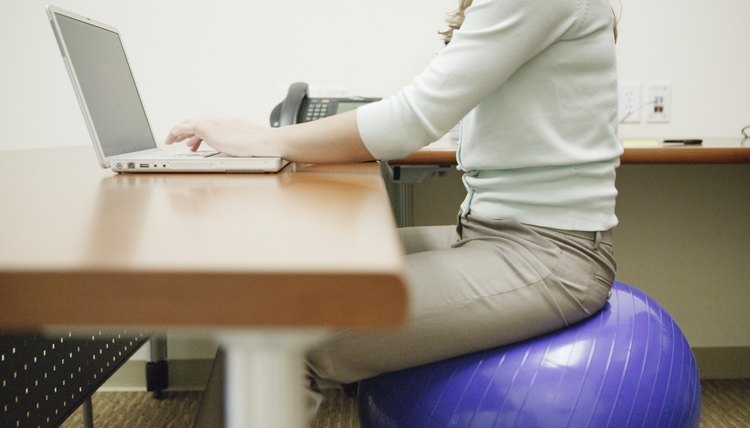Cons of Using an Exercise Ball All Day

You may have seen news stories where people trade their office chair for an exercise ball and wondered whether you could benefit from a similar trade. Reasons for the trade include better posture, less back pain and exercise on the job. Some people who opted for exercise balls found that there were significant drawbacks to sitting on an exercise ball all day.
Fatigue
The lack of stability, arm and back support can cause fatigue if you sit on the ball for extended periods, according to Dr. Henry Goitz, chief of sports medicine at the Medical College of Ohio. He believes that long hours of ball sitting can lead to injuries when you get too tired to maintain your balance or focus on your balance and posture. Fatigue can lead to poor posture, the antithesis of why many sit on the ball. A study published in the December 2009 edition of “Scoliosis” found that individuals sitting on an exercise ball demonstrated similar slumping and poor posture habits to those sitting in chairs.
Discomfort
Sitting on the ball for hours can become painful. The balls are not ergonomically developed for extended sitting, which leads to discomfort. A study published in the May 2009 edition of “Applied Ergonomics” noted that women who typed sitting on a ball for more than one hour demonstrated spinal shrinkage and a reduction in arm flexion, leading the authors to conclude that the ball disadvantages outweigh any benefits. A May 2006 study reported in “Clinical Biomechanics” reported that extended ball sitting led to soft tissue compression and subsequent discomfort. A third study published in “Human Factors” also concluded that the balls caused discomfort with little or no redeeming advantage. Alternating sitting in a chair with sitting on the ball could reduce the discomfort during the day.
Safety
The ball can roll out from under you if you aren’t careful. Placing the ball on a stability base or ring can keep the ball in place, but may make it harder to position the ball because the ball and the base must shift together. If punctured, the ball can deflate, although most exercise balls are constructed of burst-resistant plastic so they deflate slowly to prevent injury.
Space
Sitting on a ball at the office or home may require you to reserve space for both a chair and a ball to keep you comfortable and productive. This can create problems if you have a small space and may cause the ball or chair to impede your ability to move freely within the space.
Ball Chair
Inventive manufacturers offer ball chairs to combine the perceived benefits of a ball with the stability, mobility and comfort of a chair. Some of the ball chairs have arms and a back to improve comfort. The ball sits in a wheeled frame that offers stability, adjustability and maneuverability. If you want to sit on a ball for extended periods, the ball chair may offer the best option.
References
- The New York Times: The Claim: Replacing Your Desk Chair With an Exercise Ball Can Improve Your Posture
- MSNBC: Exercise Balls as Office Furniture
- Human Factors: Stability Ball Versus Office Chair: Comparison of Muscle Activation and Lumbar Spine Posture During Prolonged Sitting
- Clinical Biomechanics: Sitting on a Chair or an Exercise Ball
- Scoliosis: A Comparative Study of the Stability Ball vs. the Desk Chair in Healthy Young Adults
- Applied Ergonomics: Static and Dynamic Postural Loadings During Computer Work in Females
Writer Bio
Rev. Kathryn Rateliff Barr has taught birth, parenting, vaccinations and alternative medicine classes since 1994. She is a pastoral family counselor and has parented birth, step, adopted and foster children. She holds bachelor's degrees in English and history from Centenary College of Louisiana. Studies include midwifery, naturopathy and other alternative therapies.
